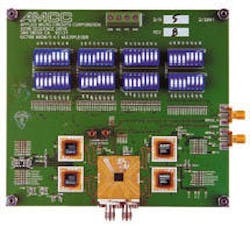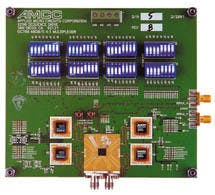Material differences appear in OC-768 chips
By STEPHEN HARDY
The road to 40-Gbit/sec (OC-768) opti cal systems will be paved in part with electronics, and several chipmakers have indicated the directions they believe that path will take. Yet, while there is agreement on where to go, it is clear that chip producers don't agree on how to get there, particularly when it comes to materials.
Several companies centered their announcements on the recent SuperComm show in Atlanta. For example, AMCC (San Diego) built on the S76800 OC-768 transimpendance amplifier (TIA) it debuted at the Conference on Optical Fiber Communications earlier this year by showing the device in an integrated package with a photodiode. (A client still operating in stealth mode performed the integration, ac cording to AMCC's Ken Prentiss, director of marketing for telecom products.) AMCC showed the device in a benchtop setting that featured live signals.
The device is the first in a series of OC-768 chips, according to Prentiss. Other devices, in order of introduction, include a modulator driver, monolithic 16:1 multiplexer, 1:16 demultiplexer, and framer. The company expects to have all these chips available in sample quantities for their system partners by the end of the year.
At the same time, Infineon Technologies (Munich, Germany, and San Jose, CA) announced it is sampling a 40-Gbit/sec multiplexer/demultiplexer chip set. The FOA4400 multiplexer and the FOA5400 demultiplexer accommodate 16 channels of 2.5 Gbits/sec to support data rates from 39.8 Gbits/sec to 43 Gbits/sec; the latter rate matches with forward error correction requirements. The interfaces use current mode logic. The chipset integrates clock and data recovery as well as a voltage-controlled oscillator. Reference clocks operate at 622 MHz and 2.5 GHz. Both chips operate at 5.5 V.The chipset inaugurates Infineon's drive to develop a complete set of chips for OC-768 line cards, according to Judith Meester, product marketing manager for high-speed semiconductors at the company. With the addition of technology from Catamaran Communications, a startup which Infineon announced in April it intends to acquire, Infineon expects to provide laser drivers, TIAs, multiplexer/demultiplexer, clock and data recovery, framer, pointer processor, mapper, and content-addressable memory-as well as optics-for high-speed optical system design.
Meanwhile, two spinouts announced that they will join forces to attack the 40-Gbit/sec market. OpNext Inc. (Eaton town, NJ), majority-owned by Hitachi, and Velocium (Manhattan Beach, CA), an operating unit of TRW Space & Electronics, will collaborate on high-speed components that OpNext will integrate into its optical transceivers. OpNext will use Velocium chips and jointly developed components in combination with other devices in transceivers it expects to take to market next year. The agreement covers amplifiers and modulator drivers.
Finally, just before the show, Vitesse Semiconductor Corp. (Camarillo, CA) outlined its OC-768 plans as well. The company plans to sample products-which will include TIAs, limiting amplifiers, and multiplexer/demultiplexer de vices-in the third quarter of this year. Using an OC-768 transceiver application as an example, Vitesse foresees a four-chip set first that includes PIN, TIA, multiplexer, and demultiplexer and consumes 5 W. The company stresses integration in its road map; thus, succeeding versions for such an application will see two integrated circuits at 3 W, then a single 2-W device, by the end of 2003.
While the four announcements outline common aims, the companies divide neatly into two camps when it comes to their approaches to device development and production. AMCC and Infineon plan to use silicon germanium (SiGe), which Vitesse and the OpNext/Velocium partnership will pursue indium phosphide (InP) technology. Subsequent to the show, other manufacturers indicated that these two material technologies may not be a developer's only choices.
The choice of material is important because it can affect performance, manufacturability, and flexibility, particularly as this last factor applies to integrating multiple functions into a single chip. Vitesse chose InP because the company believes it offers better performance than SiGe across a wider variety of applications, according to Alan Huelsman, director of the company's Indium Phosphide Project. Vitesse cites expectation of Ft/Fmax figures of 150 each in its initial release, growing to 170/200 and 180-250 in future releases. InP also offers a clear path toward integration, Huelsman says.
In particular, InP offers high breakdown voltages, according to Huelsman, which is particularly important for modulator applications. For example, Vitesse expects its initial devices to have breakdown voltages of 4-7 V, with succeeding generations achieving a consistent 7 V. SiGe cannot match this performance across all modulator applications, Huelsman claims.
AMCC's Prentiss says that breakdown voltage figures depend on how they are measured. While conceding that SiGe will not work well with LiNbO3 modulators due to issues with swing voltage, Prentiss says the technology will do fine in other modulator applications such as with electro-absorption devices. As noted, AMCC plans to introduce a modulator driver shortly us ing the SiGe process it has licensed from IBM. In addition, SiGe supports single-chip 16:1 multiplexer/demultiplexer applications significantly better than does InP, Prentiss states.
At the same time, SiGe wafer technology currently supports higher yields than InP, according to Infineon's Meester. SiGe wafers in 300-mm sizes are currently possible, Meester points out. (Vitesse says it has achieved 4-inch InP HBT wafers, with an expectation to graduate to 6-inch wafers by 2004.) The company is currently integrating multiple functions on SiGe at 10 Gbits/sec, and Meester expects no significant roadblocks to similar achievements at 40 Gbits/sec.
However, best of breed may prove the final answer. Francis Hawkings, senior vice president, business strategy, at OpNext, suggests his company may look at SiGe or even gallium arsenide for devices that complement the InP chips covered in the Velocium deal. In particular, chips for multiplexer/demultiplexer functions may be best constructed from materials other than InP, Hawkings feels.
Meanwhile, tried-and-true CMOS should not be discounted. Jean Marc Patenaude, director, optical transport products at Broadcom Corp. (Irvine, CA), reports his firm plans to continue its emphasis on CMOS when turning its attention to 40 Gbit/sec. Broadcom is already working on test chips, particularly oscillators, that show promise. Patenaude predicts that Broadcom will have something "pretty workable" by next year using a 0.13-micron process. However, he expressed skepticism that significant demand would appear in the short term for such high-speed devices. This slowdown in demand will benefit companies such a Broadcom, he feels, because it will increase the time available to bring 40-Gbit/sec components to market.
While the choice of material may prove to be insignificant in the long run, provided the devices work, the fact that chip developers are pursuing different technologies should bode well for the availability of 40-Gbit/sec chipsets with a useful amount of functionality by the end of this year.
If you have an idea for a news story or would like to contribute to Lightwave, please contact editorial director Stephen Hardy at tel: (603) 891-9454 or e-mail: [email protected]. Ideas must focus on topics related to fiber optics and optoelectronics in the communications industry.

